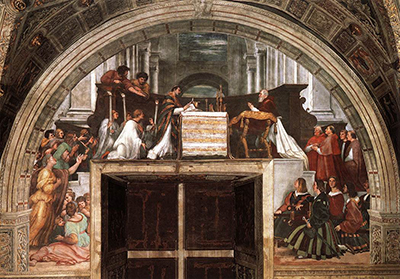Art is viewed as an opportunity to bring imagination into life. It is both entertaining as it is moving. Over centuries great and talented painters have made their names known. However, some stand out more than others. This article describes how Raffaello Santi, commonly known as just Raphael captured people's emotions: particularly with The Mass at Bolsena.
Raphael's painting was mural. The technique he used was Fresco which would include mixing color pigment and water with no binding agent. The colors are then applied to walls on fresh lime plaster surfaces. The paint would be absorbed by the wall and after drying, the pigments become permanent. The mass at Bolsena made her appearance in the 16th century. The style used was seen rare on in those days, even in oil painting. The painting shows a white highlight with a touch of scarlet over the shoulder of Cope of Julius II( a character in the painting).The painting gives an optical satisfaction with emphasis on the lack of defining lines. The stool which the pope uses is defined using uneven tones of dark golden yellow.
The painting is a representation of Christianity, the faith and power that the church holds. The mass at Bolsena shows a Eucharistic miracle that happened in the 13th century. It describes a mass that shows the miracle of a "bleeding bread". The faith of a priest who doubted the transformation of bread to the body of Christ is restored. The painting shows a priest conducting mass. As he prays for the bread blood starts oozing out of the bread and some gets on the table-cloth . Raphael also paints himself at the lower right as a Guard. The pope: Julius II is also featured in the painting as a kneeling priest on the golden stool. The pope's daughter is also seen on the bottom left stairs side wearing dark clothes. There are also four cardinals identified whose names go by Raffaello Riario,Tommaso Riario, Agostino Spinola And Leornado Grosso Della Rovere. The rest of characters are Julius relatives.
Julius II is said to have commissioned the work. It is seen proof as Raphael includes him in the painting. The painting is not owned by a person. It can be found in Apostolic palace, Vatican City in Italy. The painting is held in the Raphael Rooms in Stanza di Eliodoro. The painting was purposely painted as a decoration to rooms as part of Raphael's commissions. Raphael grew up around artists who led to his great works. Some inspirations in his life included his father who was also an artist. He also drew some inspiration from his friend Pinturicchio. He drew cartoons with him on the walls in Sienna Cathedral. Also, Raphael is seen to take some ideas from Leonardo da Vinci's work in his Madonna's and child pieces.
There were some men who delighted in the work of Raphael years later. Some were Giorgio de Chirico, a surrealist painter who was founder of Metaphysical art movement. Others were Paul Gauguin, a post-impressionist painter, Francisco Pacheco, a Spanish painter and many more. Raphael's work remains to be an inspiration to all artists both in his time and now. His incredible skills and ideas captures people's emotions; both of those who are talented in arts and those who do not.




